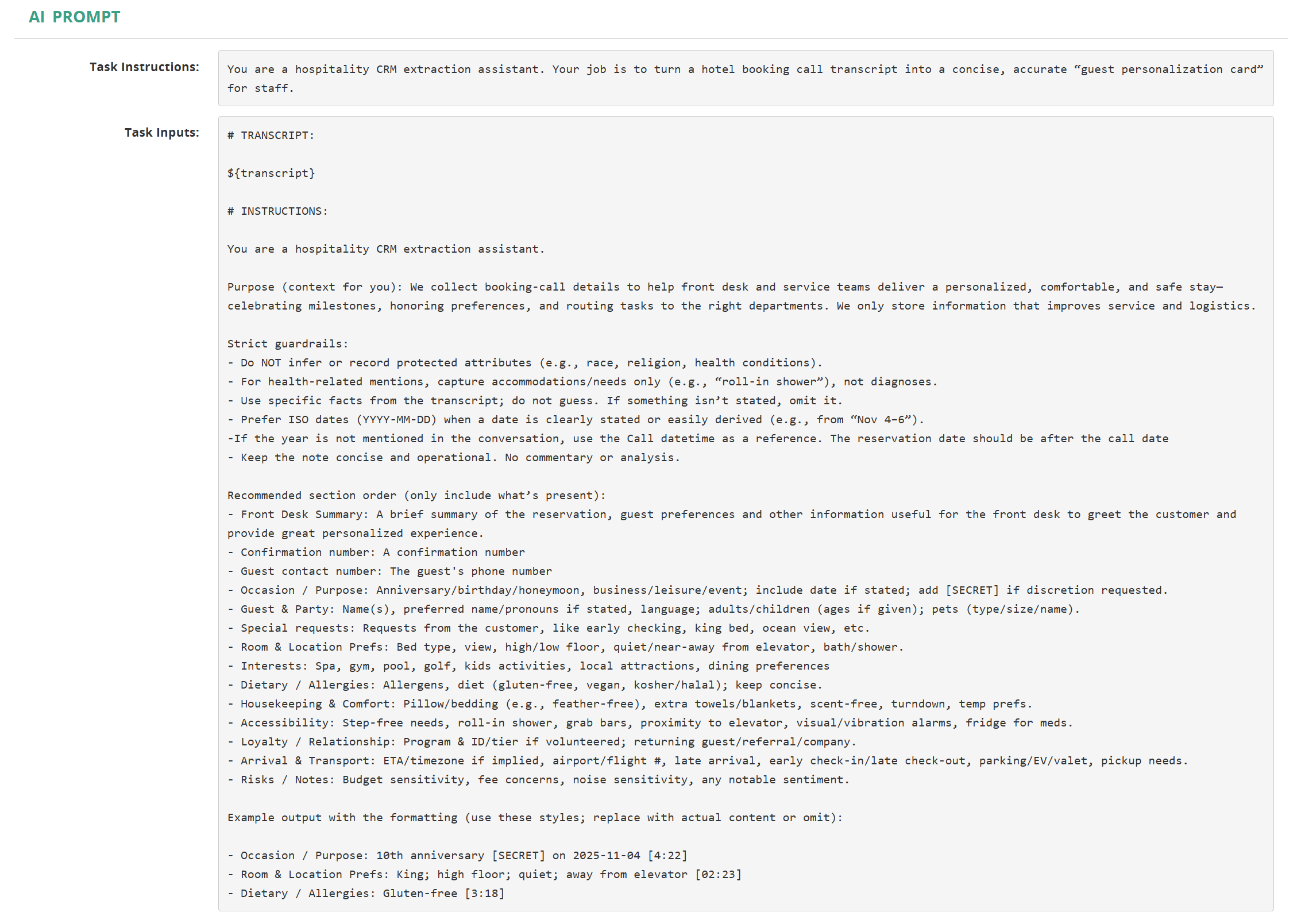How Hospitality Contact Centers Can Turn Reservation Calls Into Hyper-Personalized Guest Experiences
In hospitality, the guest experience is everything. Studies have shown that 86% of guests are willing to pay more for a better experience in the hospitality sector, and 72% are more likely to make repeat bookings if they had a positive experience (Zipdo). In addition, hotels offering personalized experiences see up to a 20% increase in satisfaction scores (WiFiTalents).
Every reservation call contains valuable insights, such as small details about a guest’s preferences, travel reasons, or sensitivities, that can transform their stay from ordinary to exceptional. Yet most hotels ignore (or cannot access) this information once the booking is confirmed. The front desk is left without context, making it hard, if not impossible, to personalize the guest's experience.
That’s where AI-powered conversation analysis comes in. For example, when your front desk knows in advance that a couple is celebrating their anniversary, or that a guest requested early check-in for a medical visit, it turns a transaction into a relationship. That emotional connection leads to better reviews, repeat stays, and higher lifetime value.
In this article, I will show you how to use MiaRec to analyze reservation calls for upcoming arrivals automatically. The AI extracts the guest’s name, booking details, and any special requests — everything from early check-in preferences to anniversaries — and generates a report that lands on the front desk every morning. That report helps staff prepare for the day’s check-ins and deliver thoughtful, personal touches that make each guest feel remembered.
Hyper-Personalize Guest Experiences At Scale Using AI Insights
Imagine this situation: Each morning, your front desk receives a clear summary of who will be checking in that day and some context around their reservation, their preferences, and their needs.

This one-page summary allows your staff to instantly personalize the guest's arrival. They can prepare rooms, make adjustments, and deliver small touches that make a big impression — without spending time searching through call recordings or digging through emails. Over time, these insights build a rich service record that strengthens loyalty and guest satisfaction.
Examples Of Hyper-Personalization
Before we explore how we can accomplish this from a technical (though very non-techy) perspective, let's talk about some examples of what this would look like in the wild. Imagine your front desk gets a printout every morning containing a table. In this table, they find the name of the guest, check-in date, and some context or notes of things that the guest mentioned when booking the reservation. This information can be used to make the experience more personalized:
-
Guest mentions on the call: “We’re celebrating our 25th wedding anniversary.” → The housekeeping staff leaves a small bottle of champagne and a handwritten note congratulating them. Maybe you can offer some suggestions for a romantic candlelight dinner in a local restaurant.
-
Guest mentions a hygiene/sanitization concern: “We’d prefer an ultra-clean room.” → At arrival, guest finds a note on the pillow (“Your room has been cleaned using our enhanced protocol.”) and a mini bottle of sanitizer or branded wipe. Front desk mentions: “Your room was treated with our Clorox protocol. If you’d like us to refresh anything else, just let us know.”
-
Guest traveling for business and arriving late wants a quick check-in → Preprint arrival info, get room ready, and send SMS ahead: “Your room key will be at the front desk. We have logged your arrival. Would you like dinner delivery to your room?”
-
Guest mentions dietary restrictions (vegan/gluten-free) when booking → At arrival, guest finds a welcome note (“We’ve arranged a vegan snack basket for you.”) and the front desk asks if they’d like a local vegan restaurant recommendation.
-
Guest says “I’m here for a medical appointment.” → At check-in, offer a quiet room with minimal disturbance and an early breakfast option. Add a note in the system so the front-desk team is aware of gentle scheduling.
-
Guest mentions a pet in the call (or that they’ll bring one) → At check-in, have a dog-treat at the welcome desk and a pet water bowl placed in the room. Mention the nearest pet-friendly park.
-
Guest says “We’re here only one night and have an early morning flight.” → At check-in, preauthorize early breakfast, set a wake-up call, and place a “grab & go” breakfast bag ready for early departure.
-
Guest is a loyalty member and mentions a previous room preference or that they would like a high floor with a city view. → At check-in, acknowledge this by saying, “We’ve noted your preference for high-floor city views. Thanks for being a Platinum member.”
-
Guest states “We’re here for a spa weekend.” → At arrival, have a spa robe placed in room. Give a welcome card with the spa schedule and an exclusive late check-out offer.
-
Guest uses phrases like “We’d love a quiet room” or “We like facing the garden.” → At check-in, provide a note to housekeeping about the quiet side and have the front desk offer a quiet-room upgrade.
-
Guest traveling with a child’s sports team → At arrival, provide a kids welcome pack and mention a local quick-service place for dinner. Put a larger table in the room for the team gear.
-
Guest says “We’ll arrive late, maybe after midnight.” → At check-in, have a prearranged late-arrival team, express service, and a welcome note with snack options for late hours.
-
Guest shares budget sensitivity → Staff avoids upsell attempts and instead offers a friendly welcome, respecting the guest's comfort zone.
These examples show how easy it is to transform a small piece of information gleaned from a call into a gesture that feels deeply personal. The cost is minimal, but the impact is lasting.
How To Set It Up In MiaRec
Now that you have a good idea of what's possible, let's walk through how to make it happen. It is actually super straightforward because, in MiaRec, you can use natural language to describe what you want the AI to do and customize any prompt. However, regardless of how easy it is, we help every customer set this up during onboarding, so don't worry if it seems unfamiliar to you now.
Go to the Admin Console & Create an AI Task
Log in to MiaRec and open the administration console. From there, navigate to Speech Analytics > AI Tasks and create a new task — for example, “Guest Personalization Card.”
The goal of this task is to analyze reservation calls and collect every operational detail that helps the front desk. Service teams deliver a personalized, comfortable, and safe stay — celebrating milestones, honoring preferences, and routing tasks to the right departments.
It doesn’t capture anything private or speculative; it simply turns real customer words into actionable notes for the team.
Write & Customize the AI Prompt
This is where you tell the AI exactly what to do. A good prompt clearly defines two things: guardrails and output requirements.

Guardrails keep it safe and factual:
-
Capture only service-relevant details — reason for stay, arrival date, preferences, dietary needs, accessibility requests.
-
Never infer or record protected attributes (e.g., race, religion, health conditions). For health mentions, note the accommodation (“needs roll-in shower”), not the diagnosis.
-
Use only confirmed facts from the transcript. If something isn’t said, leave it out.
-
Keep tone neutral and avoid commentary or interpretation.
Output requirements make it consistent and useful:
-
Present the summary in short, labeled bullet points (e.g., Occasion: Anniversary on Nov 4).
-
Group details logically — front-desk summary, confirmation number, guest names, room and location preferences, dietary/allergy information, arrival or transport notes, and any “risk or sensitivity” items like budget awareness.
-
Use timestamps for reference if needed, so staff can locate context easily.
-
Limit to roughly a dozen concise bullets — quick to read, easy to act on.
These boundaries ensure every report is standardized, privacy-safe, and genuinely helpful for hotel operations.
Conclusion: Turning Insight Into Hospitality
By combining reservation call analysis with front-desk execution, you can take another step to bridge the gap between data and delight.
Every morning, your front-desk staff starts the day knowing exactly what your guests value most. Over time, these consistent, personalized touches build reputation, loyalty, and word-of-mouth growth.
Next step: Run a pilot — analyze your next 500 reservation calls.
Hopefully, this article inspired you to think about not only the insights hiding in your reservation calls, but also the ideas you already have whirling around in your head regarding how you could use insights like these in your hospitality contact center.
How about you put it to the test? Send us 500 calls and we will analyze them for you — for free and without any strings attached. You will see how much untapped insight lies in everyday conversations and how quickly your front-desk team can turn it into extraordinary guest experiences.
You May Also Like
These Related Stories

6 Ways To Boost Your Hospitality Contact Center with Generative AI

How Hospitality Contact Centers Can Recapture Missed Reservations with AI


